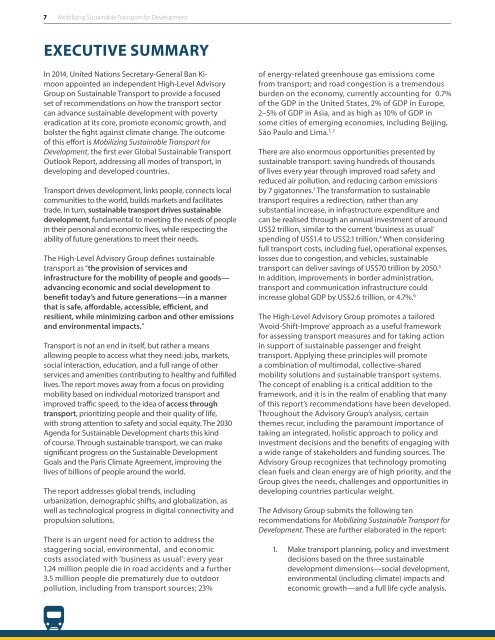MOBILIZING DEVELOPMENT
a5OQ306q56U
a5OQ306q56U
Create successful ePaper yourself
Turn your PDF publications into a flip-book with our unique Google optimized e-Paper software.
7 Mobilizing Sustainable Transport for Development<br />
EXECUTIVE SUMMARY<br />
In 2014, United Nations Secretary-General Ban Kimoon<br />
appointed an independent High-Level Advisory<br />
Group on Sustainable Transport to provide a focused<br />
set of recommendations on how the transport sector<br />
can advance sustainable development with poverty<br />
eradication at its core, promote economic growth, and<br />
bolster the fight against climate change. The outcome<br />
of this effort is Mobilizing Sustainable Transport for<br />
Development, the first ever Global Sustainable Transport<br />
Outlook Report, addressing all modes of transport, in<br />
developing and developed countries.<br />
Transport drives development, links people, connects local<br />
communities to the world, builds markets and facilitates<br />
trade. In turn, sustainable transport drives sustainable<br />
development, fundamental to meeting the needs of people<br />
in their personal and economic lives, while respecting the<br />
ability of future generations to meet their needs.<br />
The High-Level Advisory Group defines sustainable<br />
transport as “the provision of services and<br />
infrastructure for the mobility of people and goods—<br />
advancing economic and social development to<br />
benefit today’s and future generations—in a manner<br />
that is safe, affordable, accessible, efficient, and<br />
resilient, while minimizing carbon and other emissions<br />
and environmental impacts.”<br />
Transport is not an end in itself, but rather a means<br />
allowing people to access what they need: jobs, markets,<br />
social interaction, education, and a full range of other<br />
services and amenities contributing to healthy and fulfilled<br />
lives. The report moves away from a focus on providing<br />
mobility based on individual motorized transport and<br />
improved traffic speed, to the idea of access through<br />
transport, prioritizing people and their quality of life,<br />
with strong attention to safety and social equity. The 2030<br />
Agenda for Sustainable Development charts this kind<br />
of course. Through sustainable transport, we can make<br />
significant progress on the Sustainable Development<br />
Goals and the Paris Climate Agreement, improving the<br />
lives of billions of people around the world.<br />
The report addresses global trends, including<br />
urbanization, demographic shifts, and globalization, as<br />
well as technological progress in digital connectivity and<br />
propulsion solutions.<br />
There is an urgent need for action to address the<br />
staggering social, environmental, and economic<br />
costs associated with ‘business as usual’: every year<br />
1.24 million people die in road accidents and a further<br />
3.5 million people die prematurely due to outdoor<br />
pollution, including from transport sources; 23%<br />
of energy-related greenhouse gas emissions come<br />
from transport; and road congestion is a tremendous<br />
burden on the economy, currently accounting for 0.7%<br />
of the GDP in the United States, 2% of GDP in Europe,<br />
2–5% of GDP in Asia, and as high as 10% of GDP in<br />
some cities of emerging economies, including Beijing,<br />
São Paulo and Lima. 1, 2<br />
There are also enormous opportunities presented by<br />
sustainable transport: saving hundreds of thousands<br />
of lives every year through improved road safety and<br />
reduced air pollution, and reducing carbon emissions<br />
by 7 gigatonnes. 3 The transformation to sustainable<br />
transport requires a redirection, rather than any<br />
substantial increase, in infrastructure expenditure and<br />
can be realised through an annual investment of around<br />
US$2 trillion, similar to the current ‘business as usual’<br />
spending of US$1.4 to US$2.1 trillion. 4 When considering<br />
full transport costs, including fuel, operational expenses,<br />
losses due to congestion, and vehicles, sustainable<br />
transport can deliver savings of US$70 trillion by 2050. 5<br />
In addition, improvements in border administration,<br />
transport and communication infrastructure could<br />
increase global GDP by US$2.6 trillion, or 4.7%. 6<br />
The High-Level Advisory Group promotes a tailored<br />
‘Avoid-Shift-Improve’ approach as a useful framework<br />
for assessing transport measures and for taking action<br />
in support of sustainable passenger and freight<br />
transport. Applying these principles will promote<br />
a combination of multimodal, collective-shared<br />
mobility solutions and sustainable transport systems.<br />
The concept of enabling is a critical addition to the<br />
framework, and it is in the realm of enabling that many<br />
of this report’s recommendations have been developed.<br />
Throughout the Advisory Group’s analysis, certain<br />
themes recur, including the paramount importance of<br />
taking an integrated, holistic approach to policy and<br />
investment decisions and the benefits of engaging with<br />
a wide range of stakeholders and funding sources. The<br />
Advisory Group recognizes that technology promoting<br />
clean fuels and clean energy are of high priority, and the<br />
Group gives the needs, challenges and opportunities in<br />
developing countries particular weight.<br />
The Advisory Group submits the following ten<br />
recommendations for Mobilizing Sustainable Transport for<br />
Development. These are further elaborated in the report:<br />
1. Make transport planning, policy and investment<br />
decisions based on the three sustainable<br />
development dimensions—social development,<br />
environmental (including climate) impacts and<br />
economic growth—and a full life cycle analysis.


